Assessing Competitive Strategies: Amazon, Walmart, Target, and Costco
VerifiedAdded on 2023/04/20
|7
|1954
|208
Essay
AI Summary
This essay provides a comprehensive analysis of the competitive landscape between Amazon, Walmart, Target, and Costco. It addresses whether Amazon's business model is disruptive or sustaining innovation and evaluates Amazon's competitive advantage in light of Walmart and Target's strategies. The essay also examines Costco's unique position and its ability to withstand the growth of its competitors, while also considering Amazon's potential monopoly status based on recent profit increases and expansion into various sectors. The analysis draws from provided articles and a video to support its conclusions, offering a detailed perspective on the evolving dynamics of the retail industry.
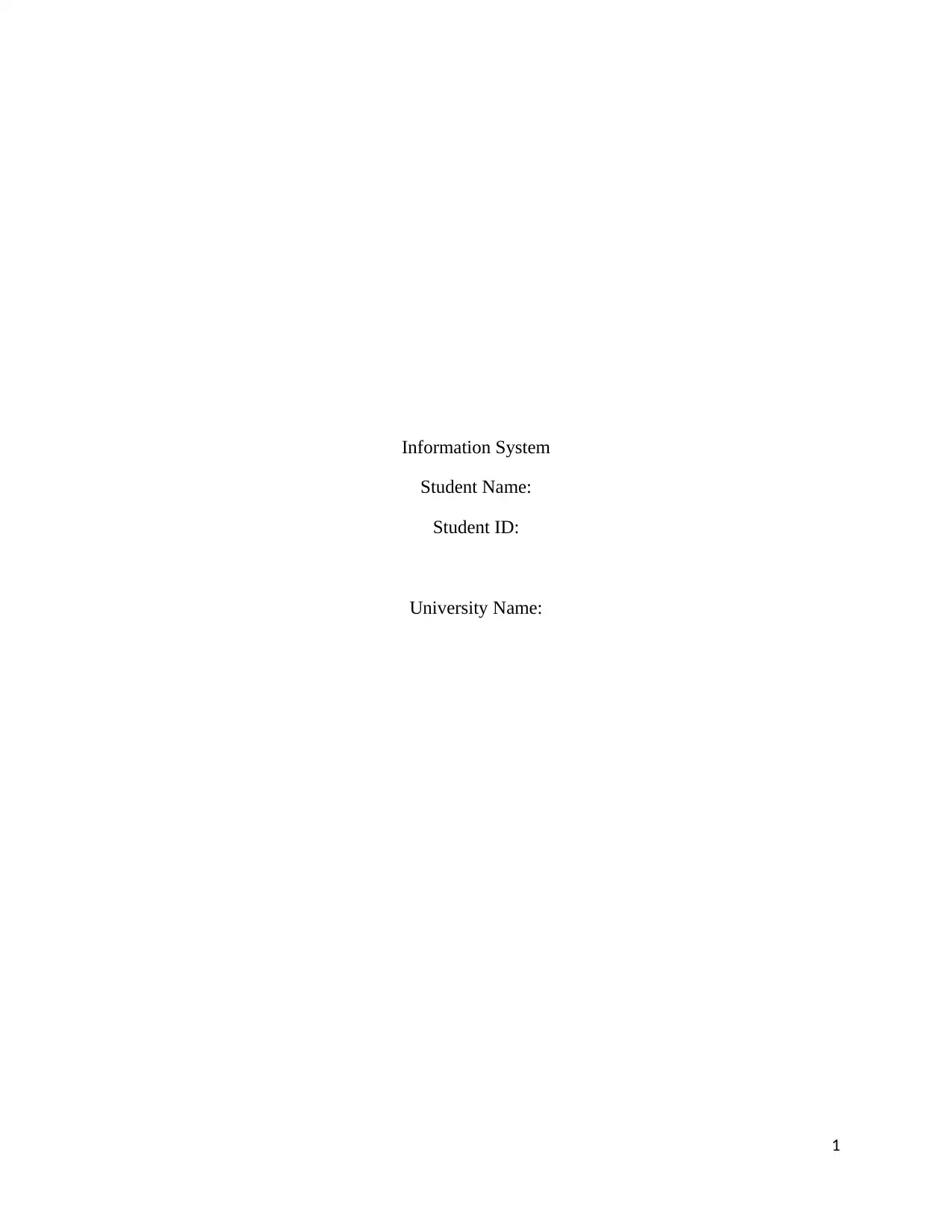
Information System
Student Name:
Student ID:
University Name:
1
Student Name:
Student ID:
University Name:
1
Paraphrase This Document
Need a fresh take? Get an instant paraphrase of this document with our AI Paraphraser
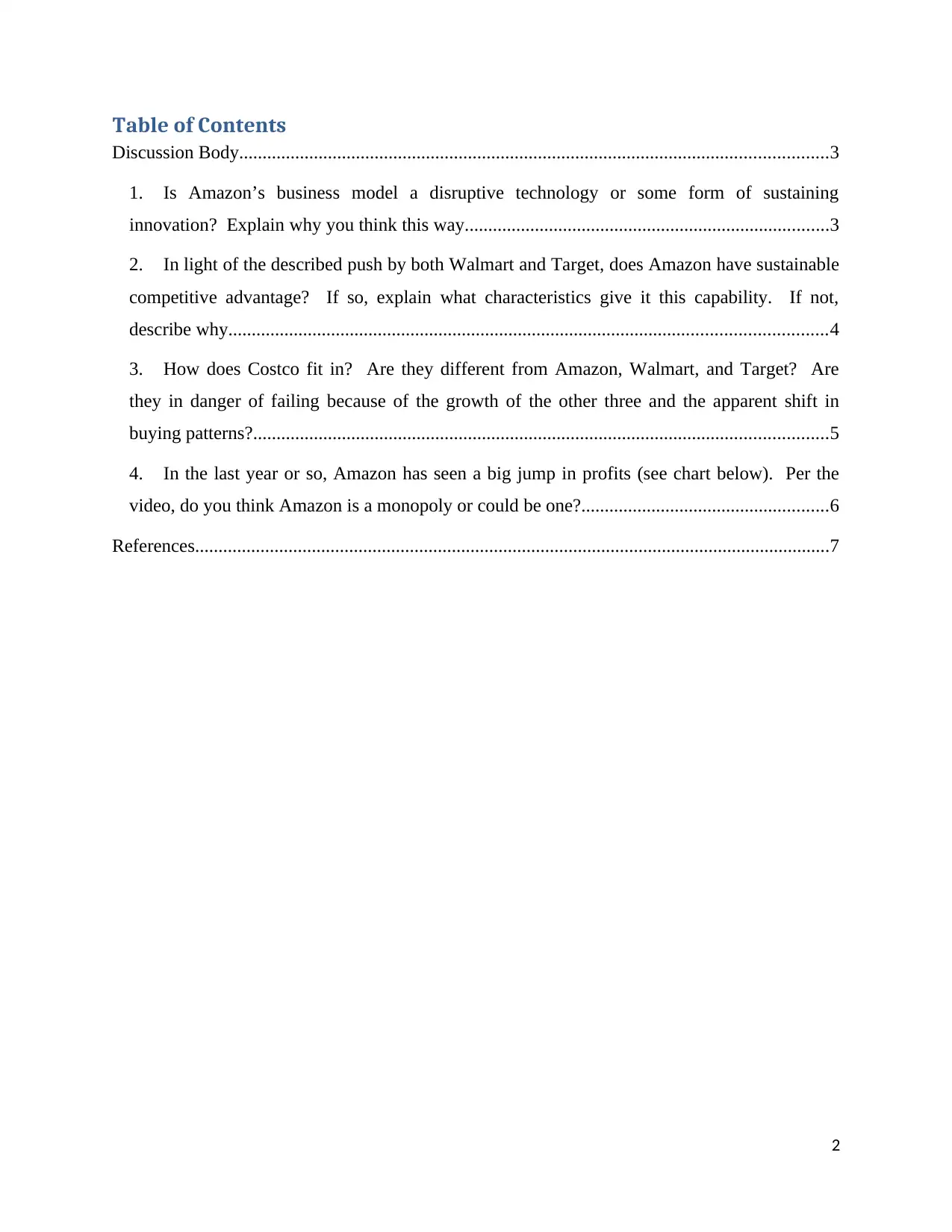
Table of Contents
Discussion Body..............................................................................................................................3
1. Is Amazon’s business model a disruptive technology or some form of sustaining
innovation? Explain why you think this way..............................................................................3
2. In light of the described push by both Walmart and Target, does Amazon have sustainable
competitive advantage? If so, explain what characteristics give it this capability. If not,
describe why................................................................................................................................4
3. How does Costco fit in? Are they different from Amazon, Walmart, and Target? Are
they in danger of failing because of the growth of the other three and the apparent shift in
buying patterns?...........................................................................................................................5
4. In the last year or so, Amazon has seen a big jump in profits (see chart below). Per the
video, do you think Amazon is a monopoly or could be one?.....................................................6
References........................................................................................................................................7
2
Discussion Body..............................................................................................................................3
1. Is Amazon’s business model a disruptive technology or some form of sustaining
innovation? Explain why you think this way..............................................................................3
2. In light of the described push by both Walmart and Target, does Amazon have sustainable
competitive advantage? If so, explain what characteristics give it this capability. If not,
describe why................................................................................................................................4
3. How does Costco fit in? Are they different from Amazon, Walmart, and Target? Are
they in danger of failing because of the growth of the other three and the apparent shift in
buying patterns?...........................................................................................................................5
4. In the last year or so, Amazon has seen a big jump in profits (see chart below). Per the
video, do you think Amazon is a monopoly or could be one?.....................................................6
References........................................................................................................................................7
2
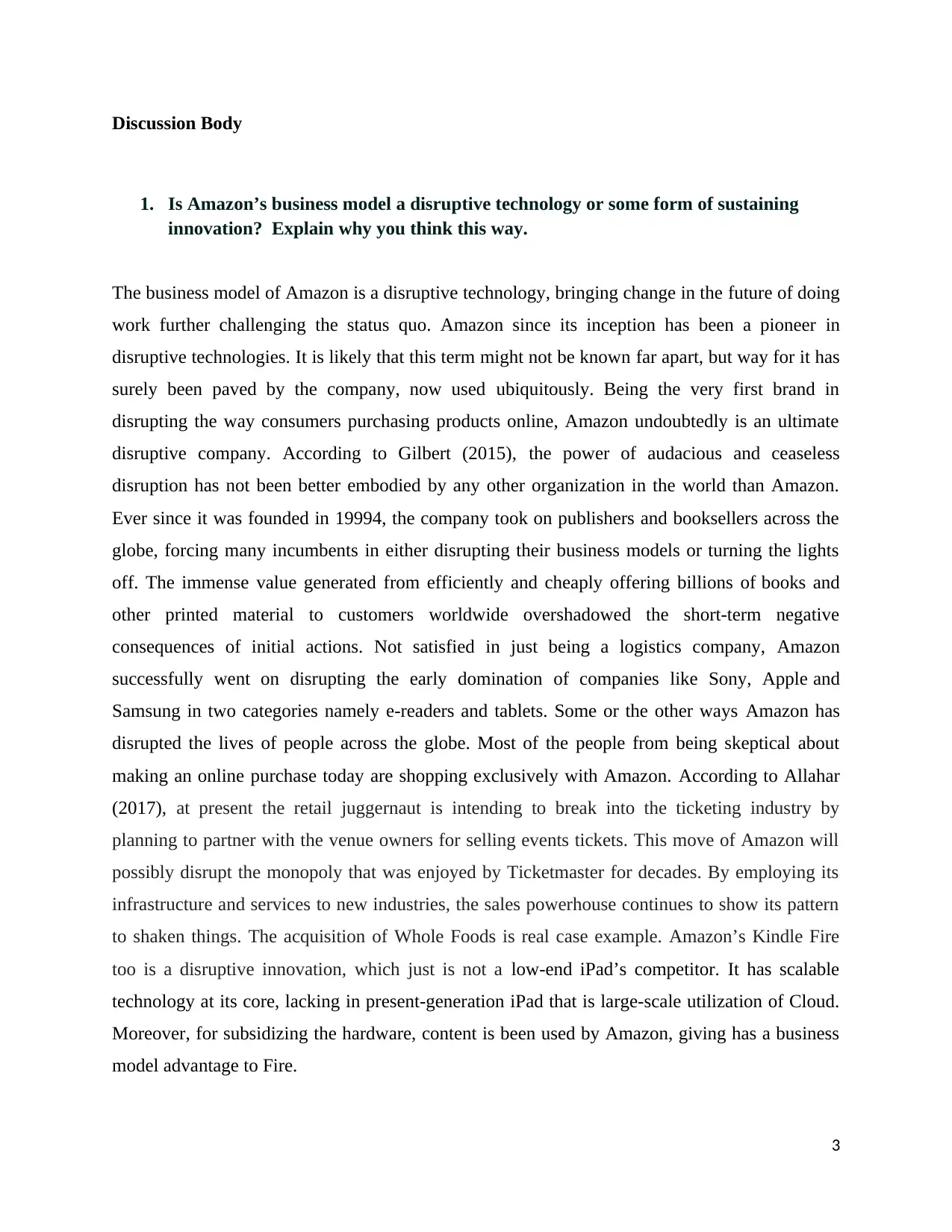
Discussion Body
1. Is Amazon’s business model a disruptive technology or some form of sustaining
innovation? Explain why you think this way.
The business model of Amazon is a disruptive technology, bringing change in the future of doing
work further challenging the status quo. Amazon since its inception has been a pioneer in
disruptive technologies. It is likely that this term might not be known far apart, but way for it has
surely been paved by the company, now used ubiquitously. Being the very first brand in
disrupting the way consumers purchasing products online, Amazon undoubtedly is an ultimate
disruptive company. According to Gilbert (2015), the power of audacious and ceaseless
disruption has not been better embodied by any other organization in the world than Amazon.
Ever since it was founded in 19994, the company took on publishers and booksellers across the
globe, forcing many incumbents in either disrupting their business models or turning the lights
off. The immense value generated from efficiently and cheaply offering billions of books and
other printed material to customers worldwide overshadowed the short-term negative
consequences of initial actions. Not satisfied in just being a logistics company, Amazon
successfully went on disrupting the early domination of companies like Sony, Apple and
Samsung in two categories namely e-readers and tablets. Some or the other ways Amazon has
disrupted the lives of people across the globe. Most of the people from being skeptical about
making an online purchase today are shopping exclusively with Amazon. According to Allahar
(2017), at present the retail juggernaut is intending to break into the ticketing industry by
planning to partner with the venue owners for selling events tickets. This move of Amazon will
possibly disrupt the monopoly that was enjoyed by Ticketmaster for decades. By employing its
infrastructure and services to new industries, the sales powerhouse continues to show its pattern
to shaken things. The acquisition of Whole Foods is real case example. Amazon’s Kindle Fire
too is a disruptive innovation, which just is not a low-end iPad’s competitor. It has scalable
technology at its core, lacking in present-generation iPad that is large-scale utilization of Cloud.
Moreover, for subsidizing the hardware, content is been used by Amazon, giving has a business
model advantage to Fire.
3
1. Is Amazon’s business model a disruptive technology or some form of sustaining
innovation? Explain why you think this way.
The business model of Amazon is a disruptive technology, bringing change in the future of doing
work further challenging the status quo. Amazon since its inception has been a pioneer in
disruptive technologies. It is likely that this term might not be known far apart, but way for it has
surely been paved by the company, now used ubiquitously. Being the very first brand in
disrupting the way consumers purchasing products online, Amazon undoubtedly is an ultimate
disruptive company. According to Gilbert (2015), the power of audacious and ceaseless
disruption has not been better embodied by any other organization in the world than Amazon.
Ever since it was founded in 19994, the company took on publishers and booksellers across the
globe, forcing many incumbents in either disrupting their business models or turning the lights
off. The immense value generated from efficiently and cheaply offering billions of books and
other printed material to customers worldwide overshadowed the short-term negative
consequences of initial actions. Not satisfied in just being a logistics company, Amazon
successfully went on disrupting the early domination of companies like Sony, Apple and
Samsung in two categories namely e-readers and tablets. Some or the other ways Amazon has
disrupted the lives of people across the globe. Most of the people from being skeptical about
making an online purchase today are shopping exclusively with Amazon. According to Allahar
(2017), at present the retail juggernaut is intending to break into the ticketing industry by
planning to partner with the venue owners for selling events tickets. This move of Amazon will
possibly disrupt the monopoly that was enjoyed by Ticketmaster for decades. By employing its
infrastructure and services to new industries, the sales powerhouse continues to show its pattern
to shaken things. The acquisition of Whole Foods is real case example. Amazon’s Kindle Fire
too is a disruptive innovation, which just is not a low-end iPad’s competitor. It has scalable
technology at its core, lacking in present-generation iPad that is large-scale utilization of Cloud.
Moreover, for subsidizing the hardware, content is been used by Amazon, giving has a business
model advantage to Fire.
3
⊘ This is a preview!⊘
Do you want full access?
Subscribe today to unlock all pages.

Trusted by 1+ million students worldwide
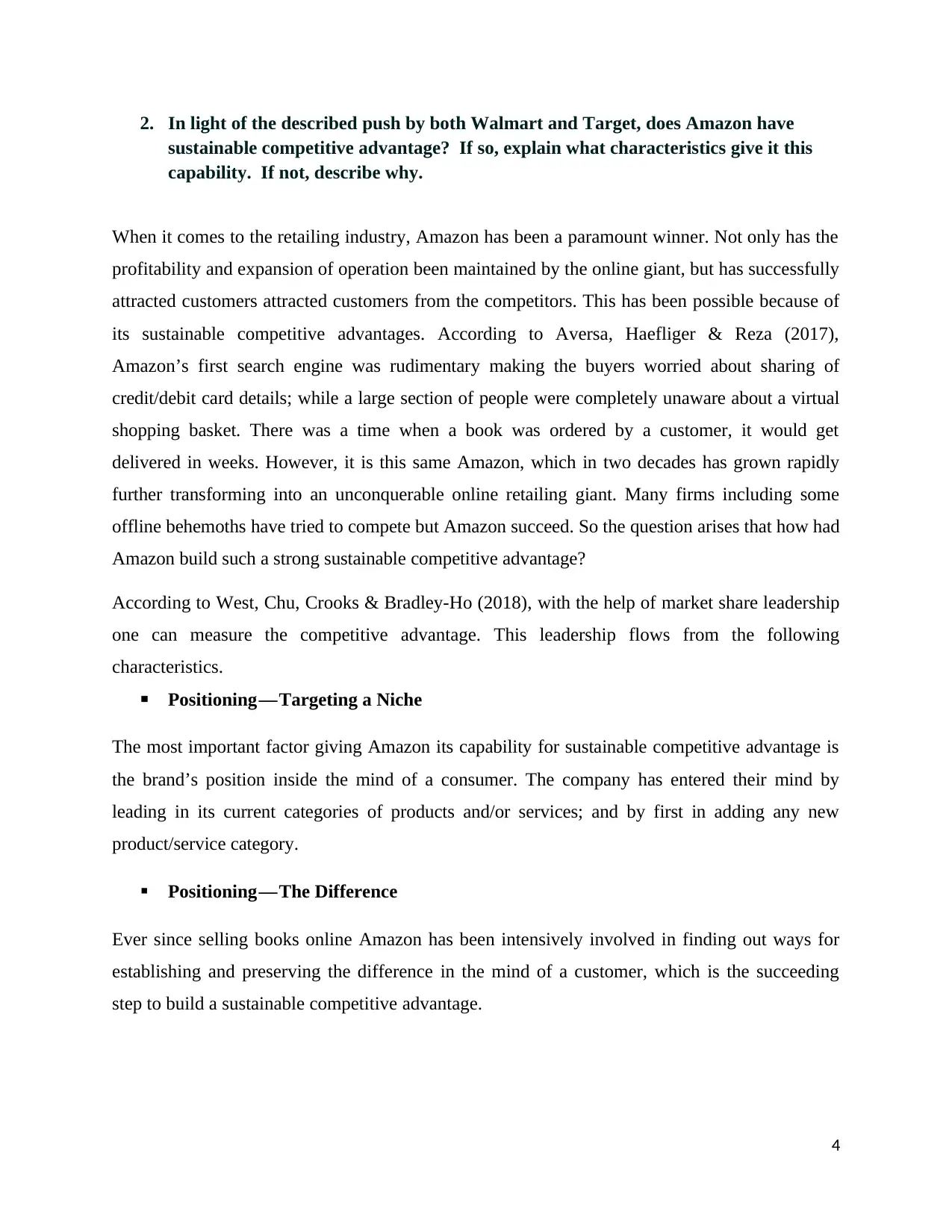
2. In light of the described push by both Walmart and Target, does Amazon have
sustainable competitive advantage? If so, explain what characteristics give it this
capability. If not, describe why.
When it comes to the retailing industry, Amazon has been a paramount winner. Not only has the
profitability and expansion of operation been maintained by the online giant, but has successfully
attracted customers attracted customers from the competitors. This has been possible because of
its sustainable competitive advantages. According to Aversa, Haefliger & Reza (2017),
Amazon’s first search engine was rudimentary making the buyers worried about sharing of
credit/debit card details; while a large section of people were completely unaware about a virtual
shopping basket. There was a time when a book was ordered by a customer, it would get
delivered in weeks. However, it is this same Amazon, which in two decades has grown rapidly
further transforming into an unconquerable online retailing giant. Many firms including some
offline behemoths have tried to compete but Amazon succeed. So the question arises that how had
Amazon build such a strong sustainable competitive advantage?
According to West, Chu, Crooks & Bradley-Ho (2018), with the help of market share leadership
one can measure the competitive advantage. This leadership flows from the following
characteristics.
Positioning — Targeting a Niche
The most important factor giving Amazon its capability for sustainable competitive advantage is
the brand’s position inside the mind of a consumer. The company has entered their mind by
leading in its current categories of products and/or services; and by first in adding any new
product/service category.
Positioning — The Difference
Ever since selling books online Amazon has been intensively involved in finding out ways for
establishing and preserving the difference in the mind of a customer, which is the succeeding
step to build a sustainable competitive advantage.
4
sustainable competitive advantage? If so, explain what characteristics give it this
capability. If not, describe why.
When it comes to the retailing industry, Amazon has been a paramount winner. Not only has the
profitability and expansion of operation been maintained by the online giant, but has successfully
attracted customers attracted customers from the competitors. This has been possible because of
its sustainable competitive advantages. According to Aversa, Haefliger & Reza (2017),
Amazon’s first search engine was rudimentary making the buyers worried about sharing of
credit/debit card details; while a large section of people were completely unaware about a virtual
shopping basket. There was a time when a book was ordered by a customer, it would get
delivered in weeks. However, it is this same Amazon, which in two decades has grown rapidly
further transforming into an unconquerable online retailing giant. Many firms including some
offline behemoths have tried to compete but Amazon succeed. So the question arises that how had
Amazon build such a strong sustainable competitive advantage?
According to West, Chu, Crooks & Bradley-Ho (2018), with the help of market share leadership
one can measure the competitive advantage. This leadership flows from the following
characteristics.
Positioning — Targeting a Niche
The most important factor giving Amazon its capability for sustainable competitive advantage is
the brand’s position inside the mind of a consumer. The company has entered their mind by
leading in its current categories of products and/or services; and by first in adding any new
product/service category.
Positioning — The Difference
Ever since selling books online Amazon has been intensively involved in finding out ways for
establishing and preserving the difference in the mind of a customer, which is the succeeding
step to build a sustainable competitive advantage.
4
Paraphrase This Document
Need a fresh take? Get an instant paraphrase of this document with our AI Paraphraser
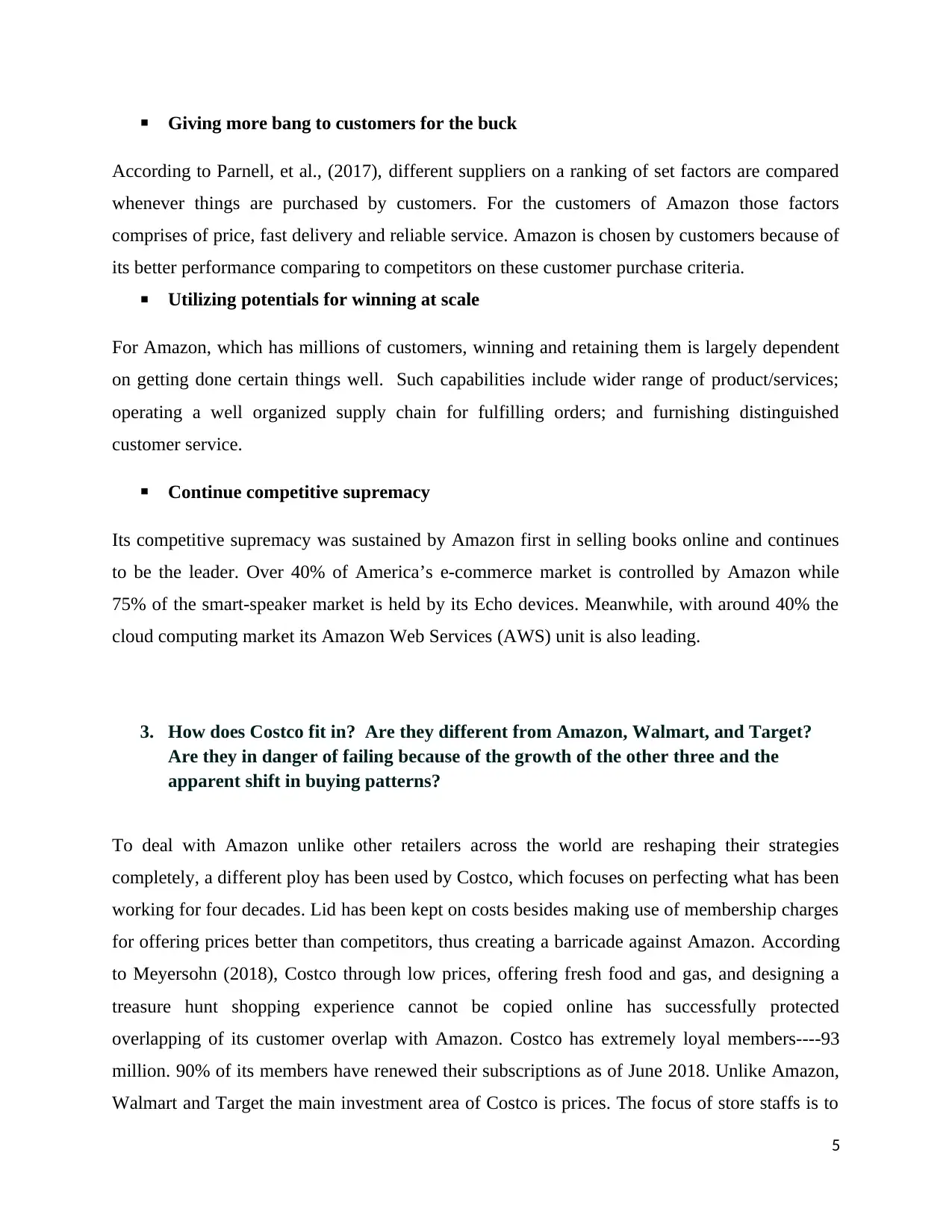
Giving more bang to customers for the buck
According to Parnell, et al., (2017), different suppliers on a ranking of set factors are compared
whenever things are purchased by customers. For the customers of Amazon those factors
comprises of price, fast delivery and reliable service. Amazon is chosen by customers because of
its better performance comparing to competitors on these customer purchase criteria.
Utilizing potentials for winning at scale
For Amazon, which has millions of customers, winning and retaining them is largely dependent
on getting done certain things well. Such capabilities include wider range of product/services;
operating a well organized supply chain for fulfilling orders; and furnishing distinguished
customer service.
Continue competitive supremacy
Its competitive supremacy was sustained by Amazon first in selling books online and continues
to be the leader. Over 40% of America’s e-commerce market is controlled by Amazon while
75% of the smart-speaker market is held by its Echo devices. Meanwhile, with around 40% the
cloud computing market its Amazon Web Services (AWS) unit is also leading.
3. How does Costco fit in? Are they different from Amazon, Walmart, and Target?
Are they in danger of failing because of the growth of the other three and the
apparent shift in buying patterns?
To deal with Amazon unlike other retailers across the world are reshaping their strategies
completely, a different ploy has been used by Costco, which focuses on perfecting what has been
working for four decades. Lid has been kept on costs besides making use of membership charges
for offering prices better than competitors, thus creating a barricade against Amazon. According
to Meyersohn (2018), Costco through low prices, offering fresh food and gas, and designing a
treasure hunt shopping experience cannot be copied online has successfully protected
overlapping of its customer overlap with Amazon. Costco has extremely loyal members----93
million. 90% of its members have renewed their subscriptions as of June 2018. Unlike Amazon,
Walmart and Target the main investment area of Costco is prices. The focus of store staffs is to
5
According to Parnell, et al., (2017), different suppliers on a ranking of set factors are compared
whenever things are purchased by customers. For the customers of Amazon those factors
comprises of price, fast delivery and reliable service. Amazon is chosen by customers because of
its better performance comparing to competitors on these customer purchase criteria.
Utilizing potentials for winning at scale
For Amazon, which has millions of customers, winning and retaining them is largely dependent
on getting done certain things well. Such capabilities include wider range of product/services;
operating a well organized supply chain for fulfilling orders; and furnishing distinguished
customer service.
Continue competitive supremacy
Its competitive supremacy was sustained by Amazon first in selling books online and continues
to be the leader. Over 40% of America’s e-commerce market is controlled by Amazon while
75% of the smart-speaker market is held by its Echo devices. Meanwhile, with around 40% the
cloud computing market its Amazon Web Services (AWS) unit is also leading.
3. How does Costco fit in? Are they different from Amazon, Walmart, and Target?
Are they in danger of failing because of the growth of the other three and the
apparent shift in buying patterns?
To deal with Amazon unlike other retailers across the world are reshaping their strategies
completely, a different ploy has been used by Costco, which focuses on perfecting what has been
working for four decades. Lid has been kept on costs besides making use of membership charges
for offering prices better than competitors, thus creating a barricade against Amazon. According
to Meyersohn (2018), Costco through low prices, offering fresh food and gas, and designing a
treasure hunt shopping experience cannot be copied online has successfully protected
overlapping of its customer overlap with Amazon. Costco has extremely loyal members----93
million. 90% of its members have renewed their subscriptions as of June 2018. Unlike Amazon,
Walmart and Target the main investment area of Costco is prices. The focus of store staffs is to
5
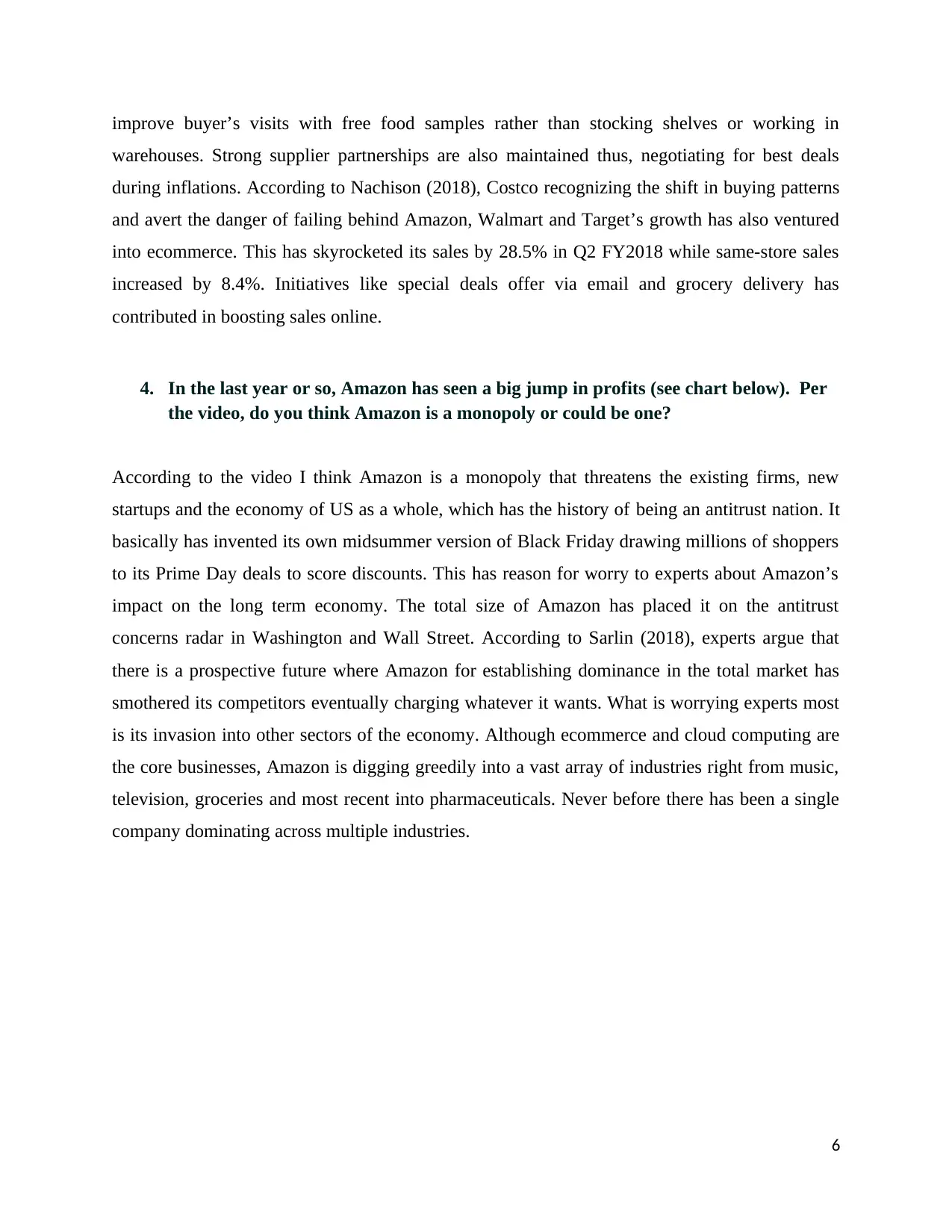
improve buyer’s visits with free food samples rather than stocking shelves or working in
warehouses. Strong supplier partnerships are also maintained thus, negotiating for best deals
during inflations. According to Nachison (2018), Costco recognizing the shift in buying patterns
and avert the danger of failing behind Amazon, Walmart and Target’s growth has also ventured
into ecommerce. This has skyrocketed its sales by 28.5% in Q2 FY2018 while same-store sales
increased by 8.4%. Initiatives like special deals offer via email and grocery delivery has
contributed in boosting sales online.
4. In the last year or so, Amazon has seen a big jump in profits (see chart below). Per
the video, do you think Amazon is a monopoly or could be one?
According to the video I think Amazon is a monopoly that threatens the existing firms, new
startups and the economy of US as a whole, which has the history of being an antitrust nation. It
basically has invented its own midsummer version of Black Friday drawing millions of shoppers
to its Prime Day deals to score discounts. This has reason for worry to experts about Amazon’s
impact on the long term economy. The total size of Amazon has placed it on the antitrust
concerns radar in Washington and Wall Street. According to Sarlin (2018), experts argue that
there is a prospective future where Amazon for establishing dominance in the total market has
smothered its competitors eventually charging whatever it wants. What is worrying experts most
is its invasion into other sectors of the economy. Although ecommerce and cloud computing are
the core businesses, Amazon is digging greedily into a vast array of industries right from music,
television, groceries and most recent into pharmaceuticals. Never before there has been a single
company dominating across multiple industries.
6
warehouses. Strong supplier partnerships are also maintained thus, negotiating for best deals
during inflations. According to Nachison (2018), Costco recognizing the shift in buying patterns
and avert the danger of failing behind Amazon, Walmart and Target’s growth has also ventured
into ecommerce. This has skyrocketed its sales by 28.5% in Q2 FY2018 while same-store sales
increased by 8.4%. Initiatives like special deals offer via email and grocery delivery has
contributed in boosting sales online.
4. In the last year or so, Amazon has seen a big jump in profits (see chart below). Per
the video, do you think Amazon is a monopoly or could be one?
According to the video I think Amazon is a monopoly that threatens the existing firms, new
startups and the economy of US as a whole, which has the history of being an antitrust nation. It
basically has invented its own midsummer version of Black Friday drawing millions of shoppers
to its Prime Day deals to score discounts. This has reason for worry to experts about Amazon’s
impact on the long term economy. The total size of Amazon has placed it on the antitrust
concerns radar in Washington and Wall Street. According to Sarlin (2018), experts argue that
there is a prospective future where Amazon for establishing dominance in the total market has
smothered its competitors eventually charging whatever it wants. What is worrying experts most
is its invasion into other sectors of the economy. Although ecommerce and cloud computing are
the core businesses, Amazon is digging greedily into a vast array of industries right from music,
television, groceries and most recent into pharmaceuticals. Never before there has been a single
company dominating across multiple industries.
6
⊘ This is a preview!⊘
Do you want full access?
Subscribe today to unlock all pages.

Trusted by 1+ million students worldwide
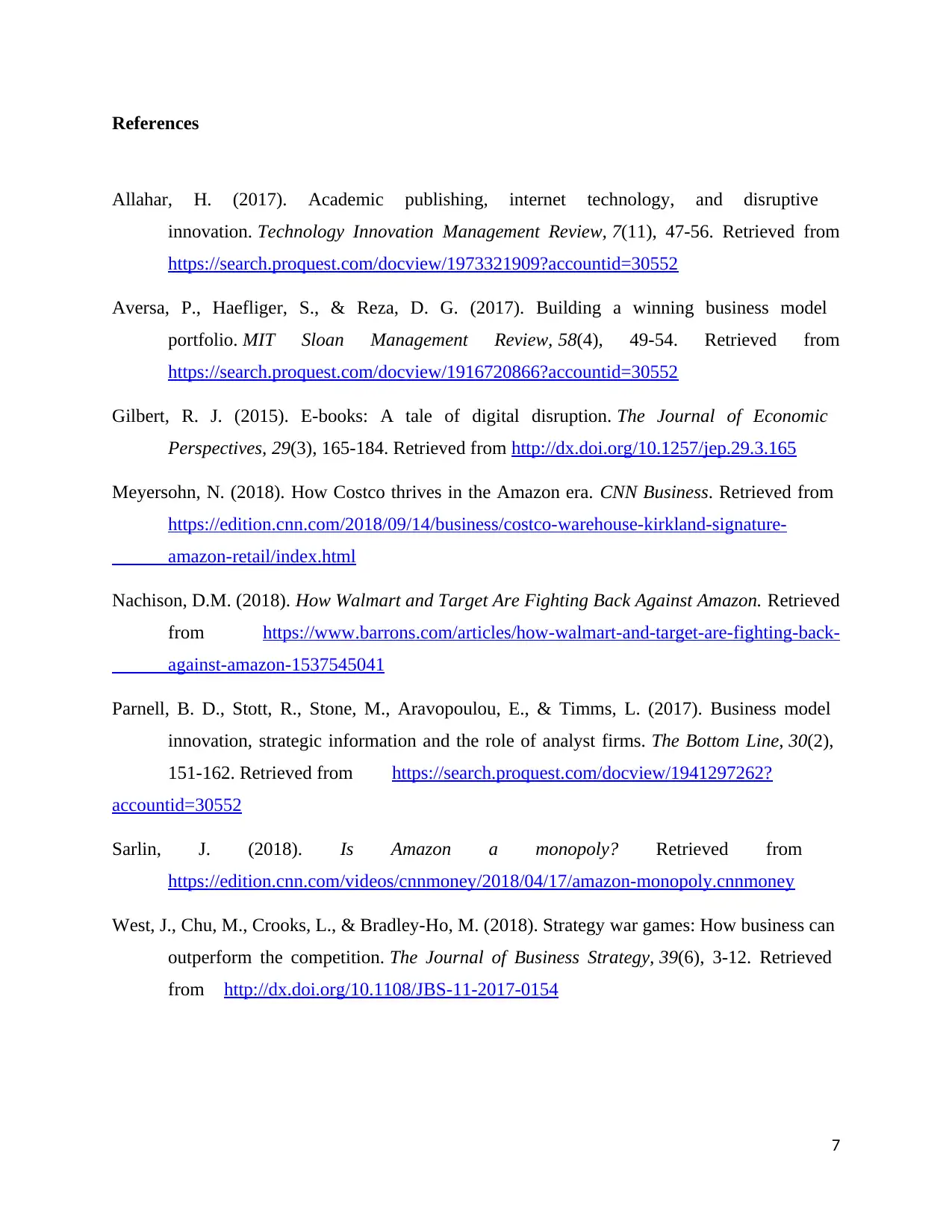
References
Allahar, H. (2017). Academic publishing, internet technology, and disruptive
innovation. Technology Innovation Management Review, 7(11), 47-56. Retrieved from
https://search.proquest.com/docview/1973321909?accountid=30552
Aversa, P., Haefliger, S., & Reza, D. G. (2017). Building a winning business model
portfolio. MIT Sloan Management Review, 58(4), 49-54. Retrieved from
https://search.proquest.com/docview/1916720866?accountid=30552
Gilbert, R. J. (2015). E-books: A tale of digital disruption. The Journal of Economic
Perspectives, 29(3), 165-184. Retrieved from http://dx.doi.org/10.1257/jep.29.3.165
Meyersohn, N. (2018). How Costco thrives in the Amazon era. CNN Business. Retrieved from
https://edition.cnn.com/2018/09/14/business/costco-warehouse-kirkland-signature-
amazon-retail/index.html
Nachison, D.M. (2018). How Walmart and Target Are Fighting Back Against Amazon. Retrieved
from https://www.barrons.com/articles/how-walmart-and-target-are-fighting-back-
against-amazon-1537545041
Parnell, B. D., Stott, R., Stone, M., Aravopoulou, E., & Timms, L. (2017). Business model
innovation, strategic information and the role of analyst firms. The Bottom Line, 30(2),
151-162. Retrieved from https://search.proquest.com/docview/1941297262?
accountid=30552
Sarlin, J. (2018). Is Amazon a monopoly? Retrieved from
https://edition.cnn.com/videos/cnnmoney/2018/04/17/amazon-monopoly.cnnmoney
West, J., Chu, M., Crooks, L., & Bradley-Ho, M. (2018). Strategy war games: How business can
outperform the competition. The Journal of Business Strategy, 39(6), 3-12. Retrieved
from http://dx.doi.org/10.1108/JBS-11-2017-0154
7
Allahar, H. (2017). Academic publishing, internet technology, and disruptive
innovation. Technology Innovation Management Review, 7(11), 47-56. Retrieved from
https://search.proquest.com/docview/1973321909?accountid=30552
Aversa, P., Haefliger, S., & Reza, D. G. (2017). Building a winning business model
portfolio. MIT Sloan Management Review, 58(4), 49-54. Retrieved from
https://search.proquest.com/docview/1916720866?accountid=30552
Gilbert, R. J. (2015). E-books: A tale of digital disruption. The Journal of Economic
Perspectives, 29(3), 165-184. Retrieved from http://dx.doi.org/10.1257/jep.29.3.165
Meyersohn, N. (2018). How Costco thrives in the Amazon era. CNN Business. Retrieved from
https://edition.cnn.com/2018/09/14/business/costco-warehouse-kirkland-signature-
amazon-retail/index.html
Nachison, D.M. (2018). How Walmart and Target Are Fighting Back Against Amazon. Retrieved
from https://www.barrons.com/articles/how-walmart-and-target-are-fighting-back-
against-amazon-1537545041
Parnell, B. D., Stott, R., Stone, M., Aravopoulou, E., & Timms, L. (2017). Business model
innovation, strategic information and the role of analyst firms. The Bottom Line, 30(2),
151-162. Retrieved from https://search.proquest.com/docview/1941297262?
accountid=30552
Sarlin, J. (2018). Is Amazon a monopoly? Retrieved from
https://edition.cnn.com/videos/cnnmoney/2018/04/17/amazon-monopoly.cnnmoney
West, J., Chu, M., Crooks, L., & Bradley-Ho, M. (2018). Strategy war games: How business can
outperform the competition. The Journal of Business Strategy, 39(6), 3-12. Retrieved
from http://dx.doi.org/10.1108/JBS-11-2017-0154
7
1 out of 7
Related Documents
Your All-in-One AI-Powered Toolkit for Academic Success.
+13062052269
info@desklib.com
Available 24*7 on WhatsApp / Email
![[object Object]](/_next/static/media/star-bottom.7253800d.svg)
Unlock your academic potential
Copyright © 2020–2025 A2Z Services. All Rights Reserved. Developed and managed by ZUCOL.




